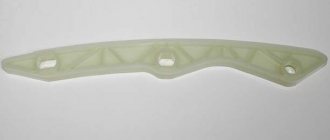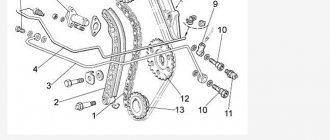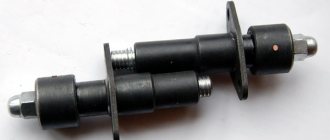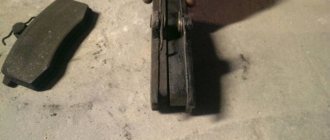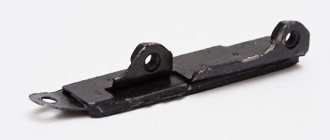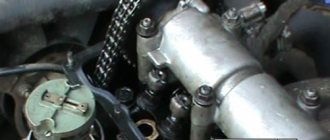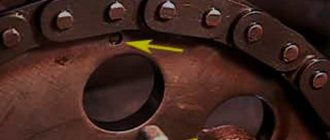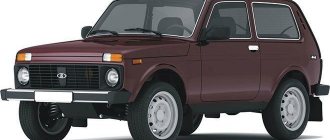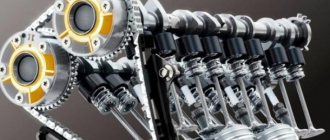Security / From Vladimir Dolzhenkov
- How to determine wear
What damage to the timing chain can cause - When is it time to change
- How to choose the right new spare part
- Video: example of replacement on a Nissan Almera car
Often car owners have to replace the timing chain. This detail should be given close attention, since the smooth operation of the gas distribution mechanism depends on it. In this case, the correctness and consistency of the procedure plays a decisive role in the correct operation of the engine.
How to determine if a chain drive is faulty
Unlike the timing belt drive, which is located outside the engine, the chain with gears is located inside the power unit and is completely hidden from view. On the one hand, this is a plus: the mechanism makes less noise and is generously lubricated with engine oil, which increases its service life. On the other hand, without removing the valve cover it is impossible to visually assess the technical condition of the unit.
The first sign of a chain drive problem is a rumbling sound coming from under the cover when the power unit is operating. The rumble of a weakened chain cannot be confused with anything; it is heard from the side where the gas distribution mechanism is located.
Loosening with a gap of up to 1 cm allows the chain to jump when starting the motor
. Having heard such a sound, the owner of the car should check the condition of the drive so as not to encounter big troubles associated with repairing the motor. There are 2 ways: immediately go for diagnostics to the nearest car service center, or remove the valve cover yourself and make sure that the section of the chain near the camshaft gear is loose. Worsening tension is caused by the following reasons:
- due to stretching to such a length that the tensioning device is unable to pick up the slack;
- due to a faulty tensioner;
- the damping plate is worn out or torn;
- Due to the high mileage of the car, all the parts of the mechanism have worn out - the chain, gears, tensioner and damper.
If an old-style mechanical tensioning device is installed in the car engine, then when the described symptoms appear, the first action is to tighten the chain with its help. To do this, simply loosen the outer nut holding the plunger spring and manually turn the crankshaft 1-2 turns. After which the nut is tightened again.
Old VAZ 2101–07 engines have a mechanical tensioner with a nut
Modern automatic hydraulic tensioners are not designed for manual adjustment and must be replaced if they break. You can verify that the element has failed only by removing it or disassembling the entire timing belt assembly. The same applies to the damper - on most cars, its wear can only be assessed when the mechanism is disassembled.
Ignoring the rumbling noise made by the chain will sooner or later lead to motor failure. The severity of the consequences depends only on your luck.
About engine maintenance
To begin with, I would like to say that the condition of the oil greatly affects the life of the chain. It is located inside, therefore, the better it is lubricated, the more the resource will increase. Also, indirectly, frequent replacement removes from the engine any debris such as sand, dirt, etc., which breaks and wears out the chain mechanism, because sand can penetrate anywhere, including into the connecting links. The new oil makes the pistons slide better, which relieves unnecessary stress on the chain mechanism.
In general, the result is this - to increase the service life, you just need to change the oil more often, at least every 1000 kilometers, but ahead of schedule. That is, the dealer claims 15,000 - change after 13 - 14,000, and ideally after 10,000, then the chain will last much longer.
A little theory
Chain drives transmit rotational force from the crankshaft to the camshaft, which is located in the cylinder head of overhead valve engines.
Chains are divided into 2 categories. They can be toothed or roller. Roller mechanisms, unlike gear ones, are not so widespread. Therefore, it is gear systems that are most often found on cars with a timing belt, which include a chain drive. Gear units are distinguished by their high smoothness, they are quite reliable, and produce an insignificant level of noise during the operation of the internal combustion engine. In terms of their characteristics, the use of toothed chains brings them much closer to belt drives. One can argue endlessly about which one is better. But we won’t dwell on this today.
The chain is tensioned due to the operation of hydraulic tensioners, for which motor oil is used as a working fluid. The lubricant is supplied through the engine lubrication system.
Depending on the number of camshafts, that is, camshafts, the number of tensioners also differs. On cars there are from 1 to 3 units.
The service life of the chain directly depends on what the element is made of, how high quality it is and the degree of effectiveness of the heat treatment performed. Similar requirements are placed on timing sprockets, since they constantly operate together with the chain. Do not forget about the influence on the condition of the unit of the engine lubrication system, the quality of the oil itself and timely replacement of the fluid. In practice, when the part is made of high-quality materials, and the correct tension was carried out as part of the service, plus lubricant was introduced on time, then replacing the chain may be necessary at the same time as replacing the motor itself.
That is, you understand that a stretched chain cannot function for a long time and effectively. If you want to extend the life of this unit, initially take a high-quality chain, adjust its tension correctly and lubricate the drive generously with high-quality oil.
Why is replacement required?
A completely natural question that many people ask. After all, if the chain is so reliable and durable, and if used correctly, it lasts as long as the engine, why are people so often interested in replacing the chain?
The operation of the timing belt directly depends on the condition, degree of wear and quality of the chain. When the motor is running, the mechanism also works actively, and under heavy loads. And in this mode, not a single element can serve forever. The process of gradual wear and tear begins. If even one tooth on the chain breaks, slippage will occur. Even this alone can lead to a series of malfunctions and complete failure of the unit. As practice shows, if the circuit breaks, problems appear with the engine valves, which must eventually be replaced. If it is a diesel engine, then there is a risk of camshaft failure. In this situation, it is necessary to change not only the chain, but also the camshaft, valves and head gasket.
Consequences of malfunctions
Problems in the timing chain drive lead to the following problems:
- A stretched and weakened chain jumps several teeth. As a rule, this happens when the engine starts.
- A chain operating with increased free play often breaks the guide and even “gnaws” a groove in the cylinder head made of aluminum alloy.
- In some brands of cars where a single-row chain is used in power units, it may break.
Note. Chain drives of the timing unit can be single- or double-row. The former are not as reliable and durable as the latter, and often break down after a run of 50-80 thousand km. Double-row drives break extremely rarely, even when the owner of the car does not pay due attention to it.
Double-row chains also break, but very rarely.
The consequences of the listed problems can be as follows:
- The most harmless option is a shift in valve timing due to the chain jumping 1-2 teeth. The engine does not start well and vibrates strongly during operation, and there is a clear loss of power while driving. When you press the accelerator pedal sharply, shots are heard in the intake manifold or exhaust pipe.
- When there is a 3 tooth offset, the engine will no longer start. Another thing is that in practice such situations are rare; a too loose chain skips much more. The result is a piston hitting a valve that opened at the wrong time.
- Due to severe wear or breakage of the damper, the chain drive is weakened even more, causing the consequences described above.
- The damage caused by a broken single-row chain depends on the type of engine and the moment when it happened. If all the valves were closed, then the pistons, which continued to move, would not reach their plates.
This is what the valves look like after meeting the pistons.
In power units with 8 valves, meeting a piston happens quite rarely due to the technological clearances provided for by the design (except for individual motors). But a 16V engine valve that is open when the chain breaks or jumps almost always receives a blow from the piston. As a result, its stem bends and the valve remains in the open position. In especially severe cases, the consequences are as follows:
- even the valve seat and guide bushing are damaged;
- a through hole appears in the upper part of the piston;
- A dent appears on the plane of the cylinder head near the combustion chamber, which makes it necessary to replace it entirely.
We recommend: Rear view camera for a car with a monitor on E-catalog
A chain that has jumped or broken while driving makes itself felt by a sharp loss of power or complete engine failure. If you were able to hear a metallic knock, indicating the meeting of the piston and valve, then you should prepare for serious repairs to the power unit.
And this is a piston pierced by a valve plate
Conventional engines
You know, I caught myself thinking that there is no information anywhere about how long to change the chain mechanism. That is, if you take a regular car, with a regular naturally aspirated engine (not a turbo - more on that below), the resource is often not limited by the manufacturer!
However, you can find the following information:
After a long mileage, about 150 - 200,000 kilometers, it is worth listening to the operation of the engine to see if there is excessive beating and noise. If it does, you need to diagnose the circuit and replace it if necessary.
That is, the main diagnosis is based on sound, and not after a certain mileage. Therefore, the resource varies from manufacturer to manufacturer, and from owner to owner.
However, if you crunch the numbers, you get:
Taking into account long maintenance (approximately 15,000 or more)
The chain lasts about 150 - 170,000 kilometers.
Taking into account short maintenance (approximately 10 – 13,000 km)
The chain can travel from 300 to 350,000 kilometers.
If you take care of your car, then the chain mechanism is really the last thing you change! But wait, my friend changed every 15 – 20,000, what’s the catch? YES in no way, it’s just that your friend has a VOLKSWAGEN engine, that is, a turbocharged one, and a weak one, with a volume of 1.2 - 1.4 liters.
At what mileage does the timing chain change?
On average, a timing chain drive lasts from 200 to 350 thousand kilometers of a car. The indicator varies depending on the driver’s driving style and the quality of the engine oil used to lubricate the links and gears. The operation of the hydraulic tensioner also depends on it.
Reference. In cars from leading German and Japanese manufacturers, a double-row chain often lasts 450-500 thousand km, or even more.
Single-row chain drive of Opel cars
In contrast to German brands, double-row drives of Korean small cars from the manufacturers KIA and Hyundai work surprisingly little. There have often been cases of stretching and replacing chains with a mileage of 60-90 thousand km on Hyundai Solaris (Hyundai Accent in Ukraine) and KIA Ceed models, which is comparable to the service life of timing belts. Hence the recommendations on when to replace the chain drive:
- On Korean small cars, you need to listen and check the condition of the drive starting from 60 thousand km. If the outcome is good, replacement is carried out in the interval of 120-150 thousand km.
- The same applies to single-row chains installed on many European economy-class cars, for example, Peugeot, Opel and small diesel engines from Audi.
- Two-row transmissions of other car brands should be given attention after 150 thousand km, periodically checking their condition. Replacement is carried out as wear occurs, but on average - no earlier than 200 thousand km.
To avoid troubles associated with timing drive failures, you need to carefully study the car’s operating instructions and the manufacturer’s recommendations for servicing a particular car.
Why does the chain stretch?
As the chain stretches, it puts less pressure on the shoe. The existing resistance to the movement of the plunger leads to its movement under the influence of oil pressure. The tensioner rod moves back, thereby compensating for the chain stretch.
The extension of the hydraulic tensioner rod is fixed, so the degree of compensation for chain stretch is limited. The length of the timing chain increases due to wear between the component parts of the chain. Due to the huge number of such parts, even a microscopic play can lead to a significant elongation of the chain.
As before, the main factor in the life of the timing chain is the design of the gas distribution mechanism parts and the quality of the component materials.
It’s time to remember the chain motors of the early 90s and late 2000s, in which, thanks to 2- and even 3-row chains, their service life was often limited to several hundred thousand kilometers.
Due to the design features and stricter requirements for fuel efficiency, modern engines are often equipped with single-row chains, the service life of which sometimes does not exceed 60-100 thousand km. Therefore, although maintenance intervals, driving style and the condition of the gears affect the rate of wear of the timing chain, the main factor is still the safety margin provided by the designers.
Symptoms of a Damaged Timing Chain
A faulty timing chain can lead to damage to the crankshaft, camshaft, pistons, and cylinder walls.
One of the signs of a damaged timing chain is a knocking noise that cannot be ignored, as well as loss of power, difficulty ignition, and idling. Another sign of a stretched timing chain is loss of power.
When the timing chain is damaged, it will interfere with engine performance. Because of this, fuel consumption may increase, as well as the level of harmful substances in the exhaust.
A loose timing chain can damage other components in the immediate vicinity.
Excessive tension and possible timing chain breakage can cause several problems such as damage to engine valves. If the timing chain is broken, the engine will not be able to start.
Also, damage to the timing chain can lead to engine overheating. Since the water pump is driven by a timing circuit, weakening the timing circuit will disrupt the operation of the water pump.
When a tooth on a gear breaks, the chain can slip, causing the valve timing to shift and the valves to contact the pistons. This damages the piston crown and causes the valves to bend, leading to major engine repairs.
If during inspection we notice that the timing chain is very tight, then it is better to replace it with a new one before it breaks. It is important to know that incorrect timing chain installation can also cause serious engine damage.
Since replacing the timing chain has many nuances (you need to correctly set the position of the crankshaft and camshaft), it is recommended to entrust this work to a professional service center.
Symptoms of the need to replace the belt
During the operation of the car, a number of symptoms appear that make it clear that it is time to change the timing belt. They usually appear if the car owner did not service the gas distribution mechanism drive on time, or the consumable is of poor quality.
The main symptom of the need to replace the belt is the presence of any defects on its surface. Most often they appear in the form of cracks, fraying or tears. The listed defects can be identified during a visual inspection.
Cracked belt that requires replacement
Replacing the timing chain
The complexity of the procedure lies in the dismantling of attachments and disassembling the power unit, which takes up to 3 hours. Removing and installing a new drive is quite simple. If all elements need to be replaced, then before performing work, be sure to delve into the timing drive structure of your car. Example: on the same KIA Ceed, the gear is pressed onto the crankshaft under heat, so you cannot dismantle it at home. Then disassembling the engine makes no sense, since it will be possible to replace one chain.
Among the special tools, you will need a device for fixing camshafts on a 16-valve engine (judger). The rest of the tools are standard:
- a set of open-end wrenches and sockets with an extension nozzle;
- jack, wooden stands and wheel wrench;
- containers for draining motor lubricant and antifreeze;
- plumbing tools - hammer, screwdriver, pliers;
- rags.
To work, you will need an inspection ditch and a portable lamp (flashlight). Place the front-wheel drive car on the pit in such a way as to provide access to the front wheel from the timing unit side. A rear-wheel drive car is positioned as conveniently as possible; there is no need to remove the wheels.
The procedure for disassembling and removing a stretched chain
First of all, the following preparatory operations are performed:
- secure the car with anti-recoil devices;
- disconnect the throttle valve heating pipe and drain the coolant from the engine jacket;
- in a car with rear-wheel drive, you need to empty the radiator;
- drain the engine oil;
- remove the lower engine protection and mudguards that interfere with further disassembly;
- disconnect the pipes and cable from the gas pedal, which prevents the removal of the valve cover.
Timing diagram of the 8-valve VAZ 2101–07 engine
Note. It is not always necessary to drain the oil, it depends on the make of the car. For example, when replacing a chain on a VAZ 2101-07, the lubricant remains safely in the crankcase and does not interfere with the work.
In a front-wheel drive car, you will have to remove the front wheel from the timing gear side and rest the car on a wooden stand. The jack will be needed later to lift the power unit.
Timing diagram of a 16-valve engine
It makes sense to consider the disassembly procedure using the example of the Korean car Hyundai Solaris 16V; in other cars with front-wheel drive, the principle of work is not much different:
- Disconnect the high-voltage wires, unscrew the spark plugs and remove the valve covers.
- Place a jack under the engine on the right side (in the direction of travel) and lift it. Unscrew the 2 elastic support mounting brackets and the power unit cushion itself.
- Loosen the tension roller of the generator drive and remove the belt. Remove both rollers - tension and parasitic, as well as the pulley from the power steering pump.
- Unscrew the water pump pulley, and then remove the pump from the engine. Now nothing prevents you from unscrewing the generator mount and moving it to the side.
- Loosen the bolt holding the crankshaft pulley. To do this, you need to jam the flywheel with a screwdriver or ask an assistant to hold the brake pedal while the gear is engaged. Remove the pulley without losing the key.
- Unscrew all bolts securing the timing cover and pull it out.
We recommend: Do-it-yourself windshield installation
Aligning the marks on the camshaft gears
Note. When disassembling the rear-wheel drive version of the car, you do not need to remove the wheel, lift the engine and unscrew the mount. Instead, you will need to remove the radiator along with the fan.
After disassembly, you need to clean the mounting flange of the cylinder block and the cover from the remains of the old gasket and sealant, and also wipe off any oil and coolant leaks. Then, by turning the crankshaft, align all the marks stamped on the gears with the marks on the engine housing or other landmarks specified in the vehicle documentation.
There are 2 ways to loosen the chain for further removal:
- immediately unscrew the 2 bolts of the hydraulic tensioner and remove it;
- pry the latch of the clamp in the tensioner, press on the plastic shoe and loosen the chain.
After loosening, the chain drive can be easily dismantled manually, the main thing is not to disturb the position of the marks.
Installing a new part on the engine
Before assembling the mechanism, make sure that you have all the consumables available:
- timing cover gasket;
- pump gasket;
- new rubber O-rings;
- new hydraulic tensioner;
- shoes for tensioner and damper (if necessary);
- high temperature sealant.
If it is necessary to replace worn tensioner and damper shoes, this is done before assembling the chain drive. This is not a problem; they are attached with 2-3 bolts (depending on the make of the car).
The yellow marks must be aligned with the marks on the gears.
For convenience and error-free installation, manufacturers often put marks on the chain links that are aligned with the marks on the camshaft and crankshaft gears. The first two are drawn in yellow, the third in black or another color. Therefore, the chain is put on the gears taking into account these marks, and then tensioned.
How should the tensioner be replaced?
It is recommended to replace the hydraulic tensioner together with the chain drive. It is held on by two bolts that must be unscrewed to replace the part. The new tensioner is equipped with a pin that secures the plunger in its original state.
When the chain is installed according to the marks, and its slack is selected in the direction of the tension shoe, the pin is pulled out and the spring pushes out the rod, which presses on the shoe with the guide. This way the chain is tensioned.
Hydraulic tensioners of various designs
Note. While the engine is not running and there is no oil pressure in the system, the chain drive will be tensioned only by spring force. Therefore, the tension will not be too strong.
After installing and adjusting the timing chain drive, manually turn the crankshaft 2-3 turns and check the position of the marks again. There is no need to specially lubricate the chain links; this will happen automatically after starting the engine. Next, the engine is reassembled with the installation of new gaskets on the sealant.
How to choose a new set of spare parts?
Like other KAMAZ automobile spare parts, timing chains are counterfeited by handicraft and Chinese manufacturers, after which they go on sale. Cunning businessmen are constantly coming up with new ways to deceive customers, for example, placing their low-quality products in original packaging from well-known brands originally from Western Europe. To avoid running into a fake spare part when purchasing a part, follow these recommendations:
- buy the chain from official sales representatives, dealers, or in stores that have a positive reputation among other users;
- do not try to save money by looking at products from unknown manufacturers;
- check the part for marks and deflection in a horizontal position;
- consult a familiar auto mechanic about which brand is best to choose for your car brand;
- Make a visual inspection of the product for careless workmanship or other signs - burrs, play between links, and so on.
The chain is checked for deflection as follows: take it by one end and hold it flat. The second end should sag no more than 10 mm. If possible, check the hardness of the metal by carefully filing it with a file. The steel in high-quality products is hardened, and therefore is characterized by increased hardness and does not lend itself to filing.
Chain, gears, shoes and tensioner - complete replacement kit
Advice. The main technical characteristics of the chain are its size and number of links, and you need to select the part based on them. If you are in doubt, then do not buy a new spare part without removing the old one with which you can compare it.
If you are updating a chain drive with a significant mileage of the car (150-200 thousand km), then you will have to change all the accompanying elements - gears, tensioner and damper. When the chain has stretched after a run of 50-100 thousand km, it is not necessary to change the gears, but the tensioner must be checked for functionality. Also, don't forget to buy consumables - cover gaskets, O-rings and heat-resistant sealant.
How to choose the right spare part
Timing chains come in single-row and double-row. Each option has its advantages and disadvantages.
- When installing a single-row version, the engine power increases slightly and the noise level decreases. The fact is that it is easier for the power unit to rotate one row of chain than two.
- A double-row chain leads to increased noise levels when driving, but it is much more reliable. This product is designed for a long service life.
Chains are divided into several types according to the number of links. The choice depends on the make of the car and the characteristics of the engine used in it. Thus, in VAZ 2101 and 2102 and other cars with an engine displacement of 1.2 and 1.3 liters, models with 114 links are used. A 116-link chain will be useful to the owner of a car with an engine capacity of 1.5, 1.6 and 1.7 liters (this is VAZ 2103, 2107 and Niva). It is better to check the exact information about a suitable kit in the documentation for the vehicle.
How to understand what needs to be changed: frequency according to regulations
Many car manufacturers say that the chain is designed to last the entire life of the car. Unfortunately, this is only true when using the machine in ideal conditions. Longitudinal vibrations at high speeds cause excessive tension on the component and subsequent failure.
Typically this part requires replacement every 100,000 km. If you hear knocking and metallic rumble while driving, it means the chain has stretched and is slipping. If such symptoms occur, replacement is required immediately! There may also be a decrease in engine power, a thick bluish-colored exhaust, loud sounds in the muffler, a sudden increase in engine temperature for no apparent reason - it is by these signs, which most often appear not individually, but together, that the wear of an element can be easily determined.
Have you bought any used car? Be sure to inspect the chain, even if the owner says he recently changed it.
In some cars, if there are problems with the gas distribution mechanism, a special indicator lights up on the dashboard. If the chain is not replaced in a timely manner, it will jump and damage the cylinder head. Further events depend on many factors. In the best case, the valves simply bend. In the worst case scenario, their constituent elements rupture and the cylinder block becomes unusable.
On the left is an old, stretched chain. On the right - new
Replacing a component yourself
Want to save money? It is quite possible to replace the chain with your own hands. However, this task is not an easy one, so it is better not for a beginner to take on it. Expect to spend at least 3-4 hours. You also need to prepare a place and a set of tools in advance.
Let's look at the process of replacing a chain using the Nissan Almera N16 Classic as an example.
Platform and tools
It is advisable to carry out the work where there is a lift, overpass or pit. Prepare the following tools:
- hex key 6;
- socket heads sizes 12, 13 and 14;
- chisel and hammer;
- clean cloth for wiping;
- containers into which technical fluids will need to be drained;
- adjustable and torque wrenches;
- block of wood;
- sealant and “anti-silicone” (degreaser);
- and, of course, a new chain.
We recommend: Replacing antifreeze Daewoo Nexia: instructions, draining, flushing, filling
Workflow for dismantling and installation
- The first thing to remove is the cables connected to the ignition coil. After this, you can unscrew the coils and put them aside. Be sure to label these components with numbers in the order in which they were removed - this will help avoid confusion during assembly.
From here we begin work on preparing for the chain replacement
- Separate the air pipes from the valve cover. The cover itself is secured with bolts. They also need to be unscrewed - then it will be possible to remove the part.
- Remove the right engine mount, otherwise it will interfere with further work.
- Locate the engine oil drain hole. Place a container under it and unscrew the cap. Wait until the technical fluid flows into the container. Remove the oil filter.
- Take another container. Find the lower radiator hose clamp and remove it. The coolant should also flow into the container. After this, find the radiator cap and unscrew it to remove any remaining coolant.
- Afterwards you need to remove the radiator and remove the generator drive belt. Then remove the supply hose clamp (you may need to loosen it first).
- The next task is to dismantle the cylinder head. The cover of this component is secured with four bolts. They need to be unscrewed, after which it will be possible to remove both the cover itself and the fan and its components.
- You need to remove the engine sump. This can be done by first removing the muffler (it is installed on several bolts).
- Slightly loosen the bolts that secure the pump pulley. This will make it possible to remove the belts connecting to the control and climate control components.
- Locate the space between the side of the crankcase and the crankshaft. Place a block of wood there and carefully remove the crankshaft pulley. To unscrew its bolt, use a socket head of the appropriate size. If you cannot reach the bolt, use an extension.
- Find the water pump pulley and remove it too. Under this part there is a gasket, which should also be removed. We'll have to temporarily get rid of the oil pump.
- That's it, the preparatory work is completed. You can proceed directly to dismantling the old chain. The camshaft gears are secured with bolts that must be unscrewed. The camshaft itself will have to be fixed with an adjustable wrench.
Dismantling the chain is carried out in the following order.
- Remove the damper (bar at the top).
- We remove the hydraulic tensioner and the bar responsible for tensioning the damper. It may be worth replacing the tensioner - especially if your car has an older version where the valve is in the stem rather than the head.
- Take the bottom bar and put it on the hairpin.
- We remove the chain itself.
- We get rid of the gear located at the bottom using a flat-head screwdriver.
If the tensioner in your car looks like this, it is better to replace it
- Compare the old chain with the new one. Most likely, the used version will be slightly longer than the new one. The increase in size occurs due to stretching. Place the new version in place of the old one and lubricate it with machine oil.
- That's it, all that remains is to install the parts in place. Before doing this, clean the mechanism components. Degreasing and cleaning the side of the engine is carried out using “anti-silicone” and a clean cloth.
- The new component must be installed so that the marks on it and on the pulleys match (this is important!). After this part of the work is completed, the side of the engine is lubricated with a new layer of sealant. Tighten the bolts that secure the cover and wait until the sealant sets. After this, you can perform the work in reverse order.
The same marks that must correspond to one another
Video on solving chain problems on Nissan Almera
As you can see, to replace the chain it was necessary to disassemble almost half of the main components of the car. If you are not confident in your abilities, it is better to turn to specialists. Replacing the timing chain is a job for those who know their car well.
Useful information about chain replacement and condition
Leasing a car for an individual: is it profitable?
Computer diagnostics is considered a simple but at the same time effective way to check the condition of the timing chain. But for this you will need to visit a car service that has the appropriate equipment at its disposal.
Please note that the engine and timing belt operate under constant load, at high speeds and vibration. This contributes to high tension on the chain, which can lead to subsequent destruction of the assembly.
A metallic knock indicates that the chain has already stretched or has begun to slip. Even one such sign clearly indicates that the unit needs to be changed. You should also pay attention to the chain if:
- the engine temperature rises for no apparent reason;
- valves are knocking;
- strange and incomprehensible metallic sounds appear;
- Thick smoke pours out of the exhaust pipe;
- a drop in power is felt;
- the car moves as if in jerks;
- fuel consumption increases, etc.
On many modern cars that use a timing chain drive, a special indicator is installed. With its help, a motorist can promptly replace errors associated with the operation of the gas distribution mechanism. If there is an indicator and it has worked, then you should start replacing it. If stretched, jumping will begin, and this will result in damage to the cylinder head. At best, you can get by by replacing the cylinder head gasket and changing bent valves. At worst, the entire cylinder block will need to be replaced.
How is wear determined?
Now let's talk directly about how to understand or how to find out that the timing chain assembly has worn out and needs to be replaced. Diagnosing and understanding the signs of wear and tear will save you from costly repairs.
Similar problems can happen on any machine, be it:
- Volkswagen Polo Sedan 1.6;
- Kia Sportage;
- Volkswagen Tiguan;
- Kia Rio;
- Skoda Yeti 1.2;
- Hyundai Solaris;
- Hyundai Elantra;
- Kia Spectra;
- Volkswagen Jetta, etc.
But if you look into the regulations for the maintenance and operation of some cars, you will, to your surprise, find that on many cars the plant does not provide for replacing the chain at all during the entire operating period.
That is, replacement is not carried out at a certain interval. But this is only possible under ideal operating conditions, which are almost impossible to achieve.
Experienced motorists advise changing the chain approximately every 100 thousand kilometers. This is a normal resource for a quality part.
But it’s best to start from the characteristic signs indicating wear. Namely:
- When starting the engine or idling, the engine runs rough and intermittent;
- There are strange sounds coming from the engine. Moreover, they are heard most clearly at idle with low oil pressure. The knock is characteristically metallic;
- During the diagnosis, a strong output of the chain tensioners is noted, as well as characteristic signs of wear on the sprocket teeth.
But that's not all you need to know.
Useful tips
It is recommended to regularly check the condition of the drive in accordance with the manufacturer's instructions, and also strictly adhere to timing chain replacement intervals.
Care must be taken when replacing the timing chain as this will also determine how the engine will perform. If the timing chain is not installed correctly, the engine will also not run properly. The repair must be done precisely.
Drive elements should always be replaced according to the recommendations for our vehicle. Buying quality parts will certainly extend the life of the timing chain.
